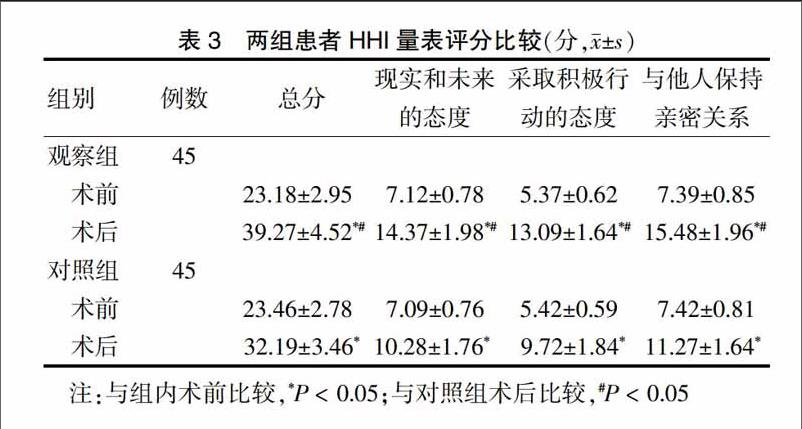治疗性沟通及干预对乳腺癌手术患者术后恢复、心理应激及希望水平的影响
詹敏


[摘要] 目的 探討治疗性沟通及干预对乳腺癌手术患者术后恢复、心理应激及希望水平的影响。方法 收集2012年5月~2016年1月在自贡市第三人民医院接受手术治疗的90例乳腺癌患者,按照随机数表法分为观察组(n=45)和对照组(n=45)。对照组患者接受常规护理,观察组患者在常规护理基础上加入治疗性沟通干预。记录两组患者的术后卧床时间、切口引流时间、总住院时间,采用肩关节Neer评分评价术后肢体功能,采用焦虑自评量表(SAS)、抑郁自评量表(SDS)评估两组患者的负面情绪,采用心理弹性量表(CD-RISC)评价患者的心理弹性;采用Herth希望量表(HHI)评估患者对于疾病康复的希望状态。 结果 观察组患者的术后卧床时间、切口引流时间、总住院时间均短于对照组(P < 0.05),出院后1、3、6个月肩关节Neer评分值均显著高于对照组(P < 0.05)。术前,两组患者的SAS、SDS、CD-RISC、HHI评分值差异无统计学意义(P > 0.05)。术后1周,两组SAS、SDS评分值低于术前,CD-RISC、HHI评分值高于术前(P < 0.05);且观察组SAS、SDS评分值低于对照组,CD-RISC、HHI评分值高于对照组(P < 0.05)。 结论 治疗性沟通及干预可促进乳腺癌患者的术后康复、增强希望水平,降低心理应激。
[关键词] 乳腺癌;治疗性沟通;术后恢复;心理应激;希望水平
[中图分类号] R47 [文献标识码] A [文章编号] 1673-7210(2017)04(a)-0177-04
[Abstract] Objective To investigate the effect of therapeutic communication and intervention on postoperative recovery, psychological stress and hope level of patients with breast cancer. Methods 90 patients with breast cancer who underwent surgery in Zigong Third People′s Hospital from January 2012 to January 2016 were divided into observation group (n=45) and control group (n=45) according to random number table. The patients in control group were given to routine nursing and the patients in observation group were given to therapeutic communication and intervention combined with routine nursing. Then postoperative bed time, drainage time, total hospitalization time of two groups were recorded, shoulder joint function was assessed by Neer score; negative emotions were evacuated by self-rating anxiety scale (SAS)and self-rating depression scale (SDS), resiliency was assessed by CD-RISC; hope state was assessed by HHI. Results Postoperative bed time, drainage time and total hospitalization time of observation group were shorter than those of control group (P < 0.05). 1, 3, 6 months after discharge, the shoulder Neer score of observation group was significantly higher than that of control group (P < 0.05). Before operation, the SAS,SDS,CD-RISC,HHI scores of two groups had no significant difference(P > 0.05). One week after operation, the SAS,SDS,CD-RISC,HHI scores of two groups were better than those before operation; the SAS score and SDS score of observation group were significantly lower than those of control group, and CD-RISC, HHI scores of observation group were significantly higher than those of control group (P < 0.05). Conclusion Therapeutic communication and intervention can promote the recovery of patients with breast cancer, enhance the level of hope, reduce the psychological stress.

